August 30, 2013
Air Date: August 30, 2013
FULL SHOW
SEGMENTS
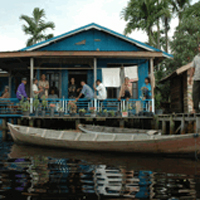
Where the Forest Ends
/ Mitra TajView the page for this story
The plantations spreading over Sumatra aren't spreading onto empty land; poor rural villages often get swept up in big decisions made in Jakarta for Indonesia's forests. Mitra Taj reports from Teluk Kabung, where the arrival of the pulpwood industry has devastated the cash crop of coconuts and left villagers with little hope for the future. (11:30)
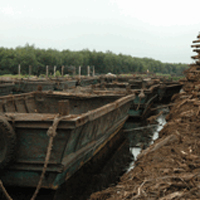
Paper Trees in Precious Ground
/ Ingrid LobetView the page for this story
Two huge plantation industries are sweeping Indonesia: palm trees used to make oil, and acacia trees used to make paper. But most of the land left for plantations in the wake of deforestation is in peat forests -- land with the highest carbon content in the world. Plantations on peat have helped Indonesia become the world's third biggest greenhouse gas emitter. The debate over emissions from peatlands is most acute in Riau province, Sumatra. Ingrid Lobet reports. (18:00)
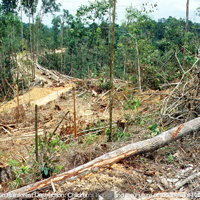
REDD Today
View the page for this story
The United Nations mechanism to reduce carbon dioxide emissions from deforestation and degradation, REDD, started with great promise. But Amy Moas, a senior forest campaigner for Greenpeace in Indonesia, tells host Steve Curwood that very little progress has actually been made. (06:25)
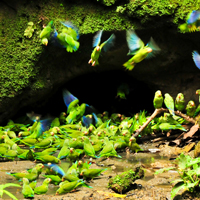
Oil or Trees
/ Bobby BascombView the page for this story
Yasuni National Park in Ecuador is home to more species of plants and animals than all of the US and Canada combined. Below the park are billions of gallons of oil. In 2007 President Correa offered to keep the oil in the ground if the international community compensated Ecuador for some of the loss of money it could have made from oil concessions. Kelly Swing, director of the Tiputini Biodiversity Station, tells Living on Earth’s Bobby Bascomb that the first of its kind plan was promising but didn’t work out as many hoped. (10:15)
Show Credits and Funders
Show Transcript
Host: Steve Curwood
Guests: Amy Moas, Kelly Swing
Reporters: Mitra Taj, Ingrid Lobet, Bobby Bascomb
[THEME]
CURWOOD: From Public Radio International, this is Living on Earth.
[THEME]
CURWOOD: In Indonesia, deforestation by big companies to grow paper and palm oil plantations leaves communities landless and poor.
MANATA: We have no land left for the next generation. The land has been taken by the company, none of it is owned by the community anymore.
CURWOOD: The UN's plan called REDD would help the villagers preserve their forest - if it could ever work -
MOAS: Palm oil is the number one driver of deforestation right now in Indonesia and there has been extensive documentation of human rights abuses and labor abuses in these local communitiies so while REDD was once proposed as an alternative to this forest destruction and to these abuses, the local communities aren't seeing the benefits just yet.
CURWOOD: We'll have these stories and more this week on Living on Earth. Stick Around!
[NEWSBREAK MUSIC: Boards Of Canada “Zoetrope” from “In A Beautiful Place Out In The Country” (Warp Records 2000)]
ANNOUNCER: Funding for Living on Earth comes from Stonyfield Farm, makers of organic smoothies, yogurt and more.
Where the Forest Ends
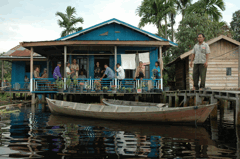
The home of Teluk Kabung resident Maharum bin Ibrahim.
CURWOOD: From the Jennifer and Ted Stanley Studios in Boston, this is Living on Earth. I’m Steve Curwood. The destruction and degradation of forests creates nearly twenty percent of global greenhouse gas emissions, more than comes from cars, trucks, ships, trains and planes put together.
Most of that forest-related CO2 comes from the tropics of South America, Africa and Asia.
So back in 2005 a group of rainforest nations proposed that the world pay to preserve their forests, rather than chop them down. The UN adopted this proposal as part of the international climate negotiations and called it REDD—reduced emissions from deforestation and forest degradation. But without a comprehensive international climate, efforts to put REDD into practice have been piecemeal.
Back in 2009 Living on Earth journeyed to Indonesia, where clearing and burning of forests and the draining of carbon-rich peat lands make it the third biggest emitter of global warming gases, behind, only China and the United States. Their mission: to see up close the obstacles and opportunities for REDD. In Teluk Kabung, reporter Mitra Taj found deforestation has devastated the cash crop of coconuts and has left villagers with little hope for the future, except, perhaps for the promise of REDD.
[MOTORCYCLE SOUND COMES UP AND UNDER]
TAJ: There’s no road that leads to Teluk Kabung. Getting there means spending half a day in a boat – or three hours on the back of a motorcycle along a rough track.
[SOUND OF MOTORCYCLE HITTING BUMP; DRIVER SAYS, “OOOOO”]
TAJ: Three and a half hours – if it rained the night before.
[DRIVER SPEAKING INDONESIAN: “HUJAN HUJAN, AIR, BAHSA!”]
TAJ: Yus, the motorcycle driver, explains the messy ride in simple words: rain, water, wet!
[MOTORCYCLE ACCELERATES; DRIVER SPEAKING INDONESIAN: “GAMBUT”]
TAJ: “Gambut,” he adds – Indonesian for “peat.” Though it looks like a typical muddy path, what's under the wheels is actually carbon-rich peatland. A good part of peat is already water. Add a night’s rainfall to it, and driving on gambut is like driving on “gado-gado,” a popular Indonesian dish of vegetables covered in peanut sauce.
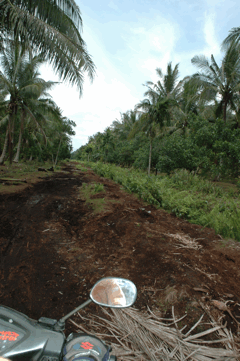
The muddy path into the village of Teluk Kabung.
[BRAKING AND TAKING OFF SOUND]
TAJ: Far from Jakarta, far from even the Riau provincial capital of Pekan Baru, and farther still from the corporate headquarters of pulpwood and oil palm companies; villagers from Teluk Kabung have a hard time getting their concerns heard.
[SQUEAKY SHELLING SOUND]
TAJ: And their biggest concerns have to do with coconuts.
[SHELLING SOUND; YUS SPEAKING INDONESIAN]
VOICEOVER: In our village language this is coconut shelling.
[SHELLING SOUND, BOYS LAUGHING]
TAJ: Teenage boys take whole coconuts – as big as bowling balls – and heave them down onto machetes fixed to poles.
[SHELLING SOUND CONTINUES]
TAJ: After prying out the hairy brown center – the familiar coconut found in supermarkets – they toss aside the husks into piles. Villagers crush the white coconut flesh for oil, which they sell to dealers, who sell it to dealers, who sell it to an oil company.
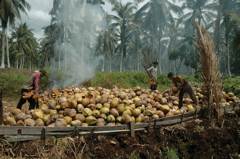
Shelling coconuts.
[WALKING SOUNDS]
TAJ: Coconuts are everywhere in Teluk Kabung. The discarded shells – pressed into the peat – literally pave the narrow footpaths into the village.
[WALKING SOUNDS; RUSTLING]
TAJ: But a few years ago, things changed – the forest surrounding Teluk Kabung’s coconut groves vanished. How much of it?
[VILLAGE MEN SPEAKING INDONESIAN]
VOICEOVER: Oh a lot! Thousands of hectares!
[VILLAGE MAN SPEAKING INDONESIAN]
VOICEOVER: When I was small, everything back there was untouched forest.
[VILLAGE MAN 2 SPEAKING INDONESIAN]
VOICEOVER: As soon as they cut down the trees in the forest, the pests swarmed in, and ate our coconut trees.
TAJ: The villagers blame an acacia supplier for Asia Pulp and Paper, or APP. Together with the multinational paper giant APRIL, APP controls about a quarter of the remaining natural forest in Riau province.
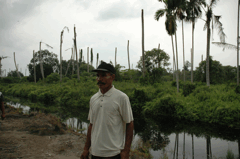
Manata and his devastated coconut grove.
[WALKING ON DRY GROUND]
TAJ: Villagers say when the forest was replaced with pulpwood plantations forest insects began thriving on their cash crop.
[WALKING SOUND; A MAN COUGHS]
TAJ: Manata is tall and strong, and leads the way to the communal coconut farm he manages just off the river.
[MANATA SPEAKING INDONESIAN]
VOICEOVER: These are our problems; this is the problem here.
TAJ: The landscape is surreal – dozens of coconut trees lie dried up on the ground. And half of those towering above have nothing on top – no palm fronds, no fruits. Just tilting trunks.
TAJ: Can we see any of the pests here?
[RUSTLING SOUND; MANATA SPEAKING INDONESIAN]
MANATA: Here’s one.
[GASP]
TAJ: Manata pulls a big black beetle from the leaves of a fallen tree – already being devoured by red ants.
[FAINT SOUND OF BOAT MOTOR; FOREST ANIMALS]
TAJ: In Indonesian peatlands, making money usually starts with draining the water out of peat. And not just for big pulpwood and oil palm plantations.
[WATER SPLASHING]
TAJ: Manata says without the drainage canal he dug here at the edge of his plantation, coconuts – or any other crop – won’t grow.
[MANATA SPEAKING INDONESIAN]
VOICEOVER: First we dug the canals, then we cleared the forest – we cut down the trees and burned everything – then we planted the coconut trees, pulling up the weeds every three months, and after seven years they were finally ready to harvest. And in 2007 we lost everything.
TAJ: Without much coconut oil to sell, there’s hunger here. Villagers can only afford to buy a tenth of the rice they used to.
[MANATA SPEAKING INDONESIAN]
VOICEOVER: It makes me want to cry the only reason I’m not crying is because I’m holding back. We have nothing else. Sometimes I can’t even look at this land, because I have no hope. I can’t compare what it’s like seeing this to anything else.
[WATER SPLASHING; BOAT STARTS UP, TAKES OFF]
TAJ: Manata steers a wooden outboard down his canal toward Gaung River, cutting through water brown from the tannins in the peat. Teluk Kabung's 12 drainage canals also guide the flow of social life for the village's 500 families. Each canal has its own coconut grove and garden plot, and its own “canal leader” like Manata.
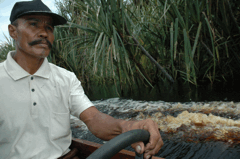
Manata steers a boat through brown, peaty water.
[BOAT MOTOR FADES; PEOPLE IN BACKGROUND SHOUTING]
TAJ: Tonight the canal leaders gather at Maharum bin Ibrahim’s house. He’s the leader of the canal leaders.
[CUTTING AND SPILLING SOUND]
TAJ: Yus, the motorcycle driver, splits young coconuts with a machete.
[GLASSES SET ON FLOOR; POURING SOUND]
TAJ: And pours a round of fresh coconut water, as Maharum begins the discussion.
[POURING SOUND; MAHARUM SPEAKING INDONESIAN]
VOICEOVER: We’re having this meeting right now to try to find a solution from the government or from the company. We've sent letters to parliament, the regent, the governor, but we haven't had any response.
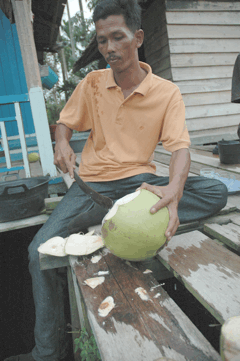
Yus prepares a round of coconut water.
TAJ: Maharum says villagers want compensation for the dead trees, and help buying pesticides to stop the plague. And they have an even longer-term worry.
[MANATA SPEAKING INDONESIAN]
VOICEOVER: We have no land left for the next generation. The land has been taken by the company. None of it is owned by the community anymore.
TAJ: In Indonesia, the size of a village’s farmland is only limited by how much work its members can put into clearing new forest to plant crops. But hard work isn’t a land title. And every year the Forestry Ministry leases out huge tracts of land to forest industries – land that might include villages, millions of tons of carbon, or habitat for endangered species. And it’s up to the companies that win the concessions to balance their own interests with everything else. Out here, threats to the environment and biodiversity translate into threats to people’s survival.
[MAHARUM SPEAKING INDONESIAN]
VOICEOVER: Ever since the company came in and cut down the trees, more and more people have been hearing the tiger, lurking in the village.
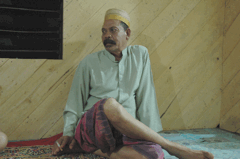
Maharum leads a discussion in his house.
TAJ: At least ten people have been killed by the endangered Sumatran tiger this year. The environmental group WWF says industrial deforestation has pushed the Sumatran tiger’s numbers down to just 250. And those that remain are straying into plantations, villages, and logging camps.
[SUPARMI SPEAKING INDONESIAN]
VOICEOVER: Here it’s very hard to find a job near your home – it’s impossible, you have to find a job somewhere else.
TAJ: 25-year-old Suparmi shares his story of being attacked by a tiger just last March:
[SUPARMI SPEAKING INDONESIAN]
VOICEOVER: Once my friends offered my brother and I some work in the forest, cutting down trees and making wood boards out of them. We were there working two weeks, and one night – we didn’t know what was going on – all of a sudden my brother was screaming. It seems he had been dragged by the foot and some of his toes were missing. I stepped outside to look around with a flashlight, and the next thing I knew it had attacked the back of my head. My friend was pulling my feet and the tiger was pulling my head and the next thing I remember were people wrapping my head with cloth.
We all left – while we were in the boat we could sense the tiger following us, walking along the riverbank. For months, my brother and I couldn't even leave the house, not even to go to the toilet. We felt like it was after us. Plus, people in the village kept saying they heard weird sounds at night – tiger sounds. The way I see it, the attack – it’s just a tragedy. We don’t understand it; we just accept it. Maybe it was a punishment from God for doing something bad.
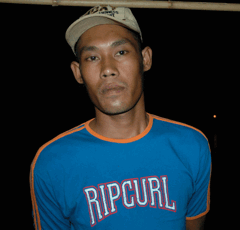
Suparmi was attacked by a Sumatran tiger at a logging camp in the forest.
[IMAM SINGS MORNING CALL TO PRAYER]
TAJ: Just before dawn, the village imam, Yamin, calls the faithful to prayer from the small wooden mosque by the river.
[IMAM CONTINUES TO SING PRAYER]
TAJ: A handful of Teluk Kabung worshippers find their way through the mud and darkness with small flashlights.
[WATER SOUND]
TAJ: They perform “wudu,” or ritual washing at a small pool in front of the mosque. After the morning prayer, Yamin reflects on the changes taking place in his village:
[IMAM SPEAKING INDONESIAN]
VOICEOVER: Destiny is like a wheel, it turns and sometimes that means we’re on top, sometimes we’re on the bottom, sometimes we’re happy, sometimes we’re sad. We must take it all as God’s will.
TAJ: If the fortunes of Teluk Kabung do turn around, it might be another palm tree that leads to better times. Villagers have found oil palm can resist the pests ravaging their coconut groves. And the canal leaders now debate whether to plant a future with palm oil.
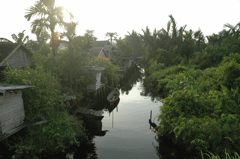
The sun rises over Teluk Kabung
[BIRD SINGS]
TAJ: The villagers have never heard of any proposal to make a living by not exploiting the land. But they say they welcome anything that will give them a say in their future.
[ROOSTER CALLS; CRICKETS CHIRP; MEN CHANTING PRAYER; MOTORBOAT PASSES IN THE DISTANCE]
CURWOOD: That’s Mitra Taj, reporting from the village of Teluk Kabung, in Riau province, Indonesia.
Related links:
- NGO coalition on deforestation in Riau, Eyes on the Forest
- For more on WWF's work on human-tiger conflict, click here.
- Ministry of Forestry English-language page
- Asia Pulp and Paper
[MUSIC: Michael Conn, Ian Ritchie & The West India Company “Indonesia” from Globe Trekker Ambient Journey’s (Pilot Film & TV Productions 2006)]
CURWOOD: Stay with us as we journey to the vanishing peat lands of Sumatra. Keep listening to Living on Earth!
[CUTAWAY MUSIC: Trombone Shorty “Vieux Carre” from Say That To Say This (Verve Records 2013)]
Paper Trees in Precious Ground
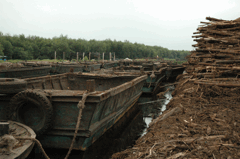
Paper and palm oil companies, and villagers too, carve canals into soggy peat for drainage and transportation—releasing stores of carbon dioxide into the atmosphere.
CURWOOD: It's Living on Earth, I'm Steve Curwood. It’s Living on Earth, I’m Steve Curwood.
Cookies and cakes. Mayonnaise, salad oil, and cooking oil. Soap and biodiesel. Many of these products and others are made using palm oil, derived from the oil palm tree that is now farmed on a huge commercial scale, especially in the Asian tropics. The region also produces large amounts of wood for paper. Paper and palm oil have made for some lucrative enterprises, but the associated forest losses are making major contributions to climate change.
REDD—the UN plan to reduce emissions from forest destruction and degradation --was designed to find more sustainable ways for people to profit from their forest lands, but when Ingrid Lobet went to the Indonesian island of Sumatra back in 2009, she found big challenges to the promise of REDD.
LOBET: To see what drives the Indonesian economy, just get out on the road. Even before sunrise you see truck after truck, loaded with orange palm fruits. Palm oil is big business around the world – for cooking oil, detergent and fuel. And there are still more trucks, laden with logs, to make paper. Soon our car stops so Arman, the driver, can have a smoke.
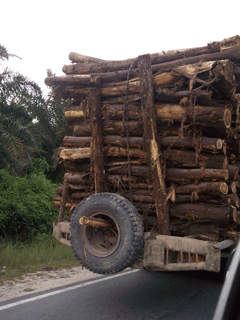
A truck carrying trees to be turned into paper.
[BIRDS SINGING; OUTDOOR SOUNDS; GIBBON IN THE BACKGROUND]
LOBET: Where we've stopped the forest is burnt away, most likely to make way for oil palm trees. In a distant stand of forest we hear gibbons. As he smokes, Arman says used to hunt them, but not anymore.
[ARMAN SPEAKING INDONESIAN]
VOICEOVER: In the forest, I came across one of these animals. I shot it four times and it fell out of the tree and leaned against it crying. It was holding a baby. It cried like a human, there were tears and it sniffed. She handed her baby to me, then sank down and died. That's when I stopped shooting animals that act like humans.
LOBET: The sound comes from way in the distance. As the trees are cut the animals are being pushed further out.
[ARMAN SPEAKING INDONESIAN]
VOICEOVER: They don’t know where to find food anymore.
LOBET: The disappearance of the forests here in Riau has been so swift. It's well documented by the environmental group WWF. But Jonotoro, who's worked here in Riau for the Forestry Ministry for 13 years, put it best:
[JONOTORO SPEAKING INDONESIAN]
VOICEOVER: Back in 1996, the forest here was still good. But after 1998, after the end of the Suharto era, it was a free for all; people just cut the forest as they pleased. There was no law enforcement. Now there’s only 20 to 30 percent of the forest left here in Riau province. That is mostly in the national parks, and even the forest there is degraded.
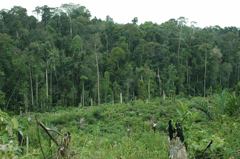
According to WWF, at least seventy percent of Riau’s forests have been cleared.
LOBET: Much of the vanished forest has given way to oil palm and to trees for paper. The voracious hunger for copier paper and for paper packaging, most recently in Asia, is bringing money, and foreigners to giant new paper mills in once quiet outposts.
KERR: My name is Dave Kerr, and I work for APRIL in Kerinci, Indonesia.
LOBET: APRIL or Asia Pacific Resources Limited is one of the largest pulp and paper companies in the world. And David Kerr, a boat building hobbyist who once worked in paper in eastern Canada, now directs operations here at this mill, really a small town in itself.
KERR: It’s gonna be really loud here!
REPORTER: What is this?
KERR: This is a chipping operation, you’ll see the logs going into the chipper, and disappearing!
[LOUD SOUND OF LOGS BEING CHIPPED, THEN MACHINE DIES DOWN]
KERR: Each chipper can take three or four thousand tons per day.
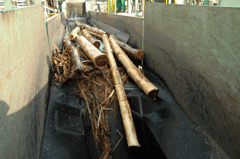
Acacia trees grown for paper are ground into chips.
[CHIPPER CHIPPING]
LOBET: Seven chipping lines swallow acacia trunks whole, and in seconds spit out thumb-sized chips of wood.
[CHIPPING MACHINE STOPS AND HUMS]
KERR: So after this the chips go to the digesters where it’s cooked, and turned into pulp.
LOBET: Pulp is the raw ingredient for paper; something the world can’t seem to get enough of. APRIL's Kerinci complex produced 800 thousand tons this year.
[VOICES AND FACTORY SOUND]
KERR: We’re about to enter Riau Paper. This is the press section and the forming area.
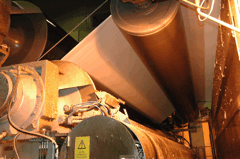
Making paper.
LOBET: Inside, the wet paper is squeezed between giant rollers, then dried, starched, and at nearly a mile a minute, crisp white paper spins onto enormous spools that each weigh more than twenty pickup trucks.
[FACTORY SOUNDS]
LOBET: The process is so fast it’s dizzying, and so loud and hot, APRIL employees monitor progress from an air-conditioned control room. They’re looking for tears, or breaks in the giant sheets.
KERR: A good day one or two breaks per day – a bad day, sometimes as much as ten.
LOBET: Does it run 24-seven?
KERR: 24-seven, 365. The only time we stop is for maintenance and that's usually measured in hours up to 12.
[SOUND OF PAPER CUTTER; STRAPPING MACHINE]
LOBET: The sheets are cut and stacked, then it's on to a printer or copier, maybe near you. But this hunger for paper and palm oil, and the forest felling that goes with it, is overwhelming even Indonesia's vast forests. So as the country pursues development, and the plantations expand, they are spreading over a very special landscape – tropical peat land.
[SOUND OF WALKING OVER DRY ORGANIC GROUND COVER]
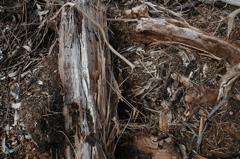
When peat forest is drained and cleared, the undecomposed plant matter in its soil is revealed.
LOBET: And the ground is a mix of acacia branches, bark, and tree material that is part of this dark brown and black peat soil. This open field was once a tropical peat land forest, a landscape unfamiliar to most Americans. Intact, it was soupy or spongy, hard to walk through. Peat forms when the water table is at ground level – or even higher. Submerged, without air, plant material doesn't decompose; it just gets compacted – into a treasure trove of stored carbon. Left alone for millions of years, it would turn into coal. But if you drain away the water by cutting canals or ditches, tropical peat lands dry out and their vast carbon stores escape into the atmosphere.
[DRY WALKING SOUND]
LOBET: In this field, a crop of pulpwood trees has just been harvested, and a new one is being planted.
BATHGATE: My name is John Bathgate. I’m a forester with a PhD in forestry. My title at the moment is plantation best practices manager.
LOBET: Bathgate is an outdoorsy New Zealander who spent ten months living in the forest among illegal tree cutters. Indonesia has vast peatlands. This island alone, Sumatra, stores more carbon in peat than is emitted globally by human activities in a year. Now much of the peat, like what we're walking on, is drained and emitting carbon at a furious rate. Many environmentalists blame plantations like this one. But, Bathgate says his company is not to blame.
BATHGATE: Just over here where these bigger trees are there is a small river. This river has been used probably for centuries or longer by local people, for fishing and hunting and gathering, and more recently for taking out timber for sale. So this land here has had quite a history of degradation and what we would call abuse – or at least not professional, high-tech development.
LOBET: When APRIL planted its first crop of pulp trees on this land he says, it was already barren. Villagers, he says, had already hacked canals into the swamp, both to float out trees they cut, and to plant crops.
BATHGATE: If, before APRIL came, this was virgin forest with the water table at the surface, then yes, we’ve got a lot to answer for. But it was like this over here. It was already – had quite a lot of illegal logging, small drains through here.
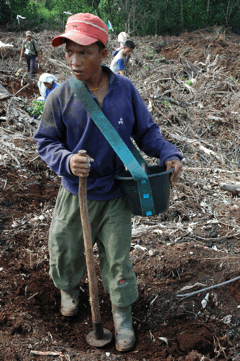
Just weeks after clearing a crop of acacia trees for paper, workers plant new seedlings.
LOBET: Today contract workers wielding heavy tampers pound the ground into flat spaces for new seedlings. I lean down close to capture the sound as the tool hits the ground, but there is virtually none; the peat absorbs it.
[FAINT SOUND OF TAMPER HITTING PEAT]
LOBET: The peat is spongy; it gives by two or three inches every time this man puts his foot down.
[SOUND OF POUNDING]
LOBET: These workers are planting seedlings of acacia, the species favored by this industry. That's because acacia grows fast – an inch a day. It sounds incredible, but in this climate, John Bathgate says these trees can be harvested for paper in just five years.
BATHGATE: So it's absolutely fantastic growth. Coupled that with that there’s high rainfall here – nearly 3,000 millimeters a year – and the fact that peat is like a big sponge absorbing and holding the moisture. So moisture for growth is available all year round. As well as that, it’s a very fine fiber for growing very soft, high quality writing paper.

APRIL’s Pelalawan nursery ships out 150,000 seedlings per day.
LOBET: And if that weren't enough to explain why the paper industry loves these trees, peat soils are quite acidic, below a pH of four. So acacia grows this fast, even with its roots marinating in the equivalent of grapefruit juice.
[MECHANICAL SOUND OF CRANE]
LOBET: On a big bare spot in this sea of paper trees, the giant claw of a Hitachi excavator grabs skinny logs out of a metal boat.
[CRANE SOUND CONTINUES]
LOBET: The cut logs floated in from the far reaches of the plantation on a canal, one of hundreds the industry carves into the peat. These canals cause carbon release, but in what's becoming a high stakes game of competing carbon claims, Bathgate says APRIL's acacia plantations actually reduce carbon emissions overall.
BATHGATE: Absolutely. What we're saying for the peat lands: we turn it from a large emitter to a less large emitter. There will still be some net emissions. On peatland, on average, we are reducing the emissions by something in the order of 50 percent.
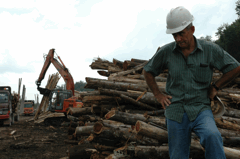
Forester John Bathgate with acacia logs barged by canal from elsewhere on the plantation. Next they'll be trucked to the mill.
LOBET: The company claims it cuts emissions by preventing fire and by setting aside 35 percent of its concessions, where forest is allowed to grow back with the water level high.
In Bathgate's view, the paper business is less harmful than the death by a thousand cuts of poor people, felling and burning the forest to plant their rice and rubber trees.
BATHGATE: I'm absolutely 100 percent convinced that leaving it to continue to degrade and leaving it for other parties to continue to degrade – it could get worse.
LOBET: But many peatland experts don't share this benign view of the plantations spreading across Indonesia. Marcel Silvius is a tropical soils expert in the Netherlands. He's lived in Indonesia, speaks the language, and was among the first scientists to point out peat's importance for carbon storage.
SILVIUS: A lot of the peat swamp forests in Indonesia are degraded. I would say about 90 percent of the peat swamp forests are degraded at the moment in Indonesian – in western Indonesia. But that doesn't mean you then have a license to go on with and even to increase the degradation by putting plantations in place of the remaining natural forest.
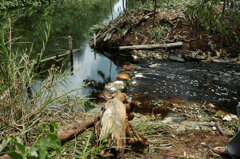
A manmade canal and dam. Water levels in acacia plantations must be carefully controlled to maximize yield.
LOBET: Silvius says APRIL's claim that plantations benefit the level of carbon in the atmosphere is just not credible. The acacia trees, he says, require at least the first two feet of peat soil to be drained, and that is not sustainable for a peat ecosystem.
SILVIUS: Peat is a soil that is consisting of organic carbon that is accumulated by the falling of leaves and decay of roots and tree trunks over thousands of years because of the waterlogged situation. And that carbon will only remain in the soil when the water levels in the area remain high. And what plantations do is they actually take the water out. And when you remove the water, the carbon will go up in the air. Because the soil carbon will react with oxygen of the air and becomes carbon dioxide, a greenhouse gas, so it warms up the earth.
LOBET: Silvius' organization, Wetlands International, estimates that in the 1990s alone, Sumatra lost 18 percent of the carbon in its soil. And when, after years, peatlands have finally given off their carbon, the damage isn't over.
SILVIUS: When the water is drained out of the peat, the soil will subside; it will become lower and lower. And then you get increased floods. And in the coastal peat swamps of Indonesia, you can get saltwater intrusion, which means that, in effect, you will render an area totally unproductive after perhaps a period of 30 to 50 years.
LOBET: In place of plantations, Silvius offers a different prescription for damaged peatlands: restore them. And that takes us to perhaps Indonesia's ground zero for forest carbon and the international money that could help keep it in the ground: a giant lowland peat storehouse known as the Kampar peninsula.
[SOUND OF GENERATOR; HAMMERING ON WOOD]
LOBET: Recently the group Greenpeace constructed a "Climate Defenders Camp," complete with kitchens, solar electricity and bunks for volunteers on one corner of this forested stretch, in hope of attracting world attention.
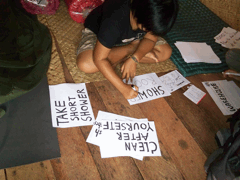
Greenpeace activists set up camp.
[SOUND OF SAWING]
LOBET: People from the villages nearby filled a new outdoor meeting room for the opening of the activist camp.
YASHWANT: [OVER P.A. SYSTEM] At a very critical time, all of us are sitting in a very important place.
[WOMAN TRANSLATES INTO INDONESIAN OVER P.A.]
YASHWANT: Protection of Kampar peninsula is not only important for the people who live around here or for the biodiversity, but it is also important to stabilize global climate.
[WOMAN TRANSLATES INTO INDONESIAN OVER P.A.]
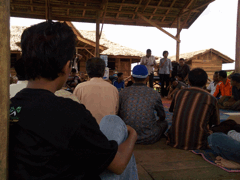
LOBET: This peat-rich peninsula perfectly illustrates the maneuvering taking place in forested parts of the globe, as players try to guarantee that global investments in forest carbon flow to them. Kampar consists of one giant dome of sodden peat. It's a rainwater-driven landscape with ground and belowground flows from the center to the periphery, into the ocean. APRIL's John Bathgate says plantations on the periphery can protect those all-important deep carbon stores in the middle.
BATHGATE: So we are one of the players that have done quite a lot of the work at looking at the value of the core and how the core could be fully protected, because that needs to happen.
LOBET: APRIL calculates plantations will reduce emissions in the periphery, or what it calls the Kampar Ring, and it hopes to market credits for that saved carbon directly to international investors.
BATHGATE: The figure we come up with is about – is a reduction of about two point six million tons of CO2 per hectare per year. At a conservative value of ten dollars – that is 26 million dollars a year to actually then be fed back into protecting the core of the Kampar peninsula, which is where the really large carbon is, and providing benefits for stakeholders. It's not just our carbon, I mean the carbon belongs to the people of Indonesia – the Ministry of Forestry of Indonesia has a stake, local communities have stake.
LOBET: But peat expert Marcel Silvius has a different idea that he says would raise more money: let the government sell carbon credits through the emerging UN forest finance system, and with the proceeds employ local people in ecology – blocking up the old illegal logging canals and restoring Kampar's damaged outer periphery.
SILVIUS: Why not just immediately restore the hydrology of the area and with that stop the soil emissions, and then plant indigenous tree species, which do not require drainage? And actually you can make a lot of money on it. From an area like Kampar it is easy to get something like 30 to 50 million dollars per year in carbon credit benefits. So we are really looking at a new and massive opportunity for conservation.
LOBET: In order to make this plan work for Kampar, the Indonesian government would need to be on board. That's part of why Greenpeace opened its camp. But after activists chained themselves to an APRIL excavator recently, many of the foreign activists were deported. Still Greenpeace workers like Bustar Maitar managed to get out the message to the newly re-elected Indonesian president, Susilo Bambang Yudhoyono, known here as SBY.
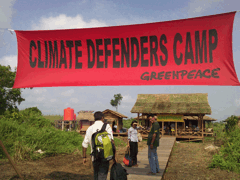
MAITAR: So if the SBY want to make a difference he supposed to be starting from here, to protect the peatland forest. Because you know 40 percent of the greenhouse gases in Indonesia is coming from the peatland destruction. So this is very important – SBY starting his commitment to reduce the greenhouse gases and starting from here. He can make a change, starting from here, in Kampar peninsula.
CURWOOD: Greenpeace worker Bustar Maitar ending that report from Ingrid Lobet in Sumatra’s Kampar Peninsula.
Related links:
- Recent Scientific Paper on Peat Emissions
- Asia Pacific Resources International Limited
- Peat Experts Wetlands International
- Environmental Collaborative Group in Riau Eyes on the Forest
- Asia Pulp and Paper
- Greenpeace Southeast Asia
[MUSIC: I Nyoman Jyus “Jalak Putih “ from Selections From The Earth (Music OF The Earth 1998)]
CURWOOD: Coming up...How REDD is actually working out in Indonesia. That's just ahead on . Living on Earth - stay tuned
ANNOUNCER: Funding for Living on Earth comes from the Grantham Foundation for the protection of the environment. Supporting strategic communications and collaboration in solving the world’s most pressing environmental problems. The Kendeda Fund, furthering the values that contribute to a healthy planet, and Gilman Ordway for coverage of conservation and environmental change. This is PRI, Public Radio International.
[CUTAWAY MUSIC: Steve Gadd: “Scatterbrain” from Gadditude (BFM Jazz 2013 , release date September 2013)]
REDD Today
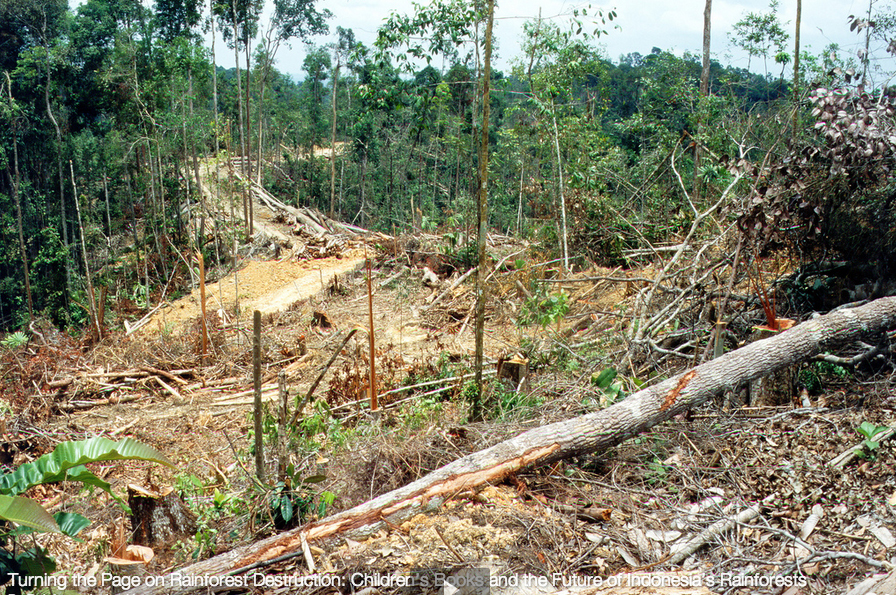
Deforestation in Indonesia continues despite a presidential moratorium on new land concessions for pulp and paper companies. (photo: Rainforest Action Network)
CURWOOD: Our team found many obstacles to forest protection in Indonesia in 2009. And four years - you might think - is long enough for the UN's REDD project to make a dent in the rate and extent of deforestation. But Indonesia's Climate Agency Chief, Agus Purnomo, sounded a note of caution to our team at the time. He pointed out that much of the remaining forest in Indonesia could be lost in the single term of an elected official.
PURNOMO: If REDD going to take 7-8 years to produce revenues, forget about it! no elected official will be interested. Are they bad people? No they are not bad, but they have to make the most of the terms, and if there is no money giong to come in until 7 years from now, why should they worry about it?
CURWOOD: So to find out how much of Indonesia’s forest REDD has actually succeeded in protecting we called up Amy Moas. She’s worked extensively in Indonesia as a senior forest campaigner for Greenpeace. Welcome to Living on Earth!
MOAS: Thank you for having me.
CURWOOD: Now tell us, generally world wide, how well is REDD working when it comes to protecting forests?
MOAS: The progress with REDD has been incredibly slow. While there is a general consensus within the international community that this is a good idea to reduce emissions through deforestation, we have not yet practically figured out how to create a program that will see real carbon emissions and protection of forests on the ground.
CURWOOD: How much of this is related to the fact that we don’t have a comprehensive climate deal for the planet?
MOAS: It is closely related. Some of the key difficultites are happening at the international climate negotiations. And some of the obstacles include how to actually monitor and verify the real carbon emission reductions. Also where is the money going to come from?
CURWOOD: Now how successful has REDD been in Indonesia as a mechanism to protect forest and peatland.
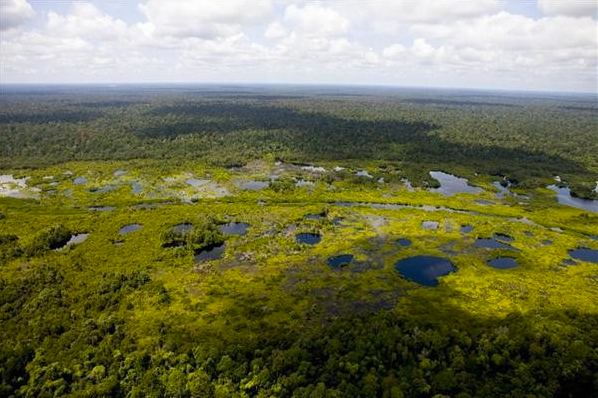
Peat land forest in the Kampar region of Indonesia. (photo: Greenpeace)
MOAS: Unfortunately it has not yet been successful. The Kampar Peninsula in particular is a critical landscape because of its high carbon rich soils. But REDD has not yet seen to be effective in protecting that area. April, a pulp and paper company, once proposed an idea to protect that Kampar Peninsula using REDD. Unfortunately it has not gotten off the ground, and we’ve actually seen April doing the complete opposite. April is destroying hundreds of thousands of acres of natural rain forest including destroying an area with high conservation value inside that Kampar Peninsula.
CURWOOD: What’s been the response of the national government of Indonesia?
MOAS: The national government of Indonesia is quite supportive of the idea of REDD. Unfortunately, most of the forest management decisions are made more at the district and local level, and its here where there is very little knowledge of what REDD will actually look like in practice. IT’s also at this level where we are more concerned about corruption.
CURWOOD: A few years ago the president of Indonesia imposed a moratorium for no more additional clearance of forests. But what’s happened here?
BOAS: Yeah that’s right. So in 2011 the president of Indonesia established a forest moratorium. It was also extended just recently in 2013. And what this means is that the government of Indonesia will not grant any new forest concessions to extractive industries, to pulp and paper companies, or to palm oil companies. A lot of these companies and industries still hold vast amounts of concessions of undeveloped land, So the rate of deforestation has not really decreased.
CURWOOD: Amy, just how fast is deforestation preceding in Indonesia at this point?
BOAS: There was a recent study that said that 80% of the island of Borneo has been deforested. That number is both shocking and true. Only about 20% of the original primary forest remains standing. If you look at just Indonesia alone, the number is about 25%, so a little bit better, but the remaining forests are in very remote areas including the islands of Siluwese and Papua, so the islands of Sumatra and Borneo have been almost completely decimated. Now these numbers are driven by the expansion of pulp and paper companies and palm oil companies as well as some other extractive industries.
CURWOOD: In the first half of the documentary we heard about how paper companies and the promise of REDD were impacting rural communities in Indonesia. What do you think is going on in those areas now?
BOAS: The local communities are the ones that are most impacted when these extractive industries, or pulp and paper companies, or palm oil companies are allowed to go in and clear-cut the forest. Palm oil is the number one driver of deforestation right now in Indonesia, and there has been extensive documentation human rights abuses and labor abuses in these local communities. So while REDD was once proposed as an alternative to this forest destruction and these abuses, it hasn’t really become operational. The local communities aren’t seeing the benefits just yet.
CURWOOD: On the whole, Amy, what kind of hope can you offer here? How optimistic are you that REDD might still be a viable way to protect the world’s rain forests and Indonesia’s forests specifically.
BOAS: Yeah, REDD definitely has the potential to change the way that forests are managed, and present and opportunity for forests to remain standing. Unfortunately we are still a ways away from that. The fundamental difficulty is actually creating a program that can monitor the carbon emissions and create an incentive to leave the forest standing. It semes like we’re still a ways off. But we do still have hope that we can find an alternative. Greenpeace firmly believes that we need both political solutions like REDD, but also market-based solutions, working with companies to improve their operations and protect forests that way.
CURWOOD: Amy Moas is a senior forest campaigner for Greenpeace. Thank you so much, Amy.
MOAS: Thank you.
Related links:
- REDD Monitor
- APRIL- Asia Pacific Resources International Limited
[Banco De Gaia “Kara Kum (Bombay Dub’s Spagetti Eastern Remix) from Eden (Six Degrees Records 2002)]
Oil or Trees
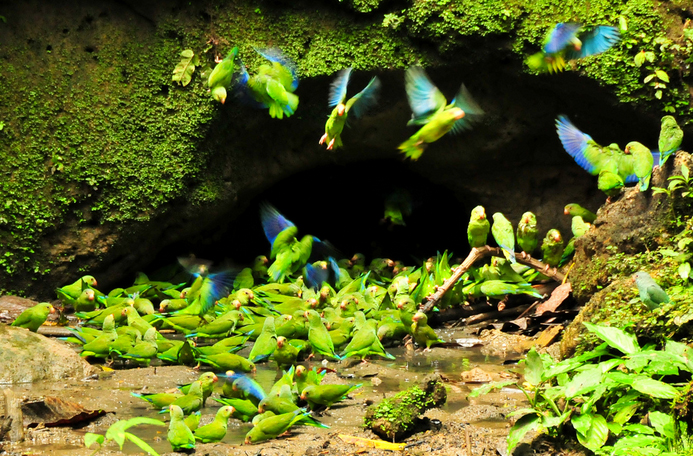
The small area of Yasuni National Park has more species of birds than all of North America. (photo: Joshua Bousel)
CURWOOD: Now back in 2007, REDD wasn't the only game in town when it came to protecting tropical forests. In Ecuador President Rafael Correa side-stepped the bureaucracy of UN negotiations to offer another way for the world to help protect part of the Amazon from development.
Yasuni National Park in the eastern Ecuadorian Amazon is one of the most biologically diverse places on the planet. And it’s not only a rich reservoir of tropical forest carbon, it also sits atop an enormous reservoir of fossilized carbon -- oil. President Correa offered to keep the oil in the ground and not disturb the park if the international community chipped in to compensate his country for the sacrifice…. something like a kickstarter for conservation.
But little money came in, so the president recently decided that his plan isn’t working and gave the green light to begin oil exploration in what's called the ITT block of Ecuador's Yasuni National Park. Here to explain what's going on is Kelly Swing. He’s director of the Tiputini Biodiversity Station in Yasuni National Park, and he told Living on Earth's Bobby Bascomb why this park matters.
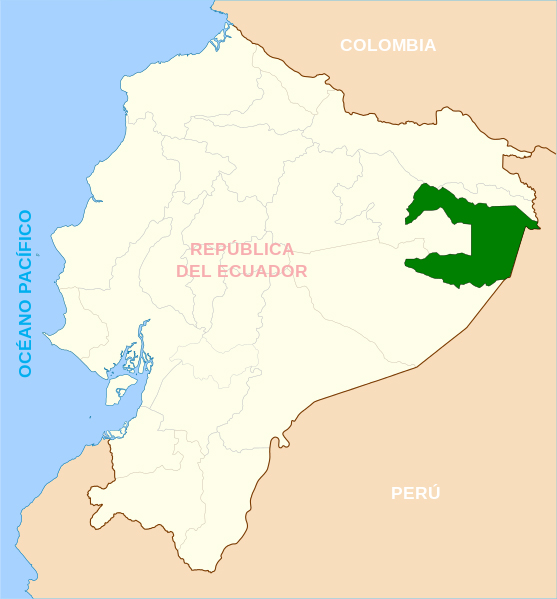
Yasuni National Park is the dark green area in eastern Ecuador. (photo: Wikimedia Commons)
SWING: I tend to say that the reason Yasuni National Park is so special, from a biological perspective, is that there simply are more species there than anywhere else. In a space the size of a football field, basically, we approach 600 species of trees, and in the U.S. and Canada combined there’s only about 560 species. If we look at that same kind of comparison for frogs, for example, 150 species in the space of a few square miles; only about 95 species in the U.S. and Canada combined. Maybe as much as a million species of insects, plants, animals, everything all together in the Yasuni National Park.
BASCOMB: Wow, it sounds like a remarkable place!
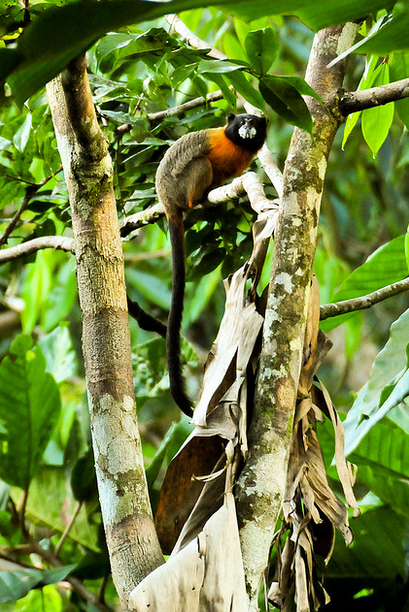
By some estimations, Yasuni National Park may be home to as much as 10% of all the plant and animal species on the planet. (photo: Joshua Bousel)
SWING: Yeah, I’ve (been) working in eastern Ecuador since the early 1990s, so basically about 20 years right here in Yasuni, and there’s always new things to see. I can go out in Yasuni and find something I’ve never seen before in two or three or four minutes, and it just goes on and on and on even after all these years.
BASCOMB: And I imagine, then, if they’re new to you, they’re probably new to science in general.
SWING: That’s correct. If we talk about the insects, in particular, it’s been estimated that 80 percent of the insects have not been described by science. Several years ago, even a zoologist was able to recognize an undescribed species of plant, and it turned out to be actually a new genus of plant! That should be a really good indication that we really don’t know much about this place, and there’s a tremendous amount of biodiversity that need to be catalogued and may actually represent very important values for science and maybe for pharmaceutical products and cures for cancer or AIDS or those kinds of things.
BASCOMB: So, Yasuni is rich in biodiversity, but it’s also rich in oil. How much oil is estimated to be in the ground under the park?
SWING: Yeah, the concession area that’s called the I-T-T Block has most of a billion barrels of oil under it.
BASCOMB: Do you know what is the value of that oil? How much is it worth?
SWING: The estimated market value for the oil that could be taken out of the I-T-T Block, several years ago, estimated at a little over seven billion dollars, but now they’re talking about a value of right around 18 billion dollars.
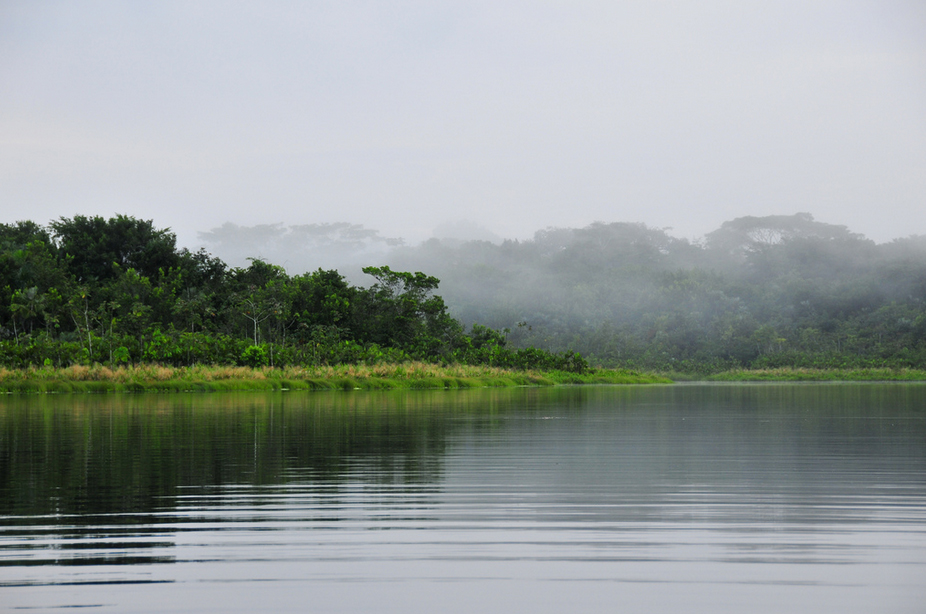
Yasuni National Park (photo: Joshua Bousel)
BASCOMB: So, about six years ago the President of Ecuador, Rafael Correa, came up with a plan to make money from the oil but not extract it from the national park. Can you tell me about that?
SWING: Basically the idea that was put forth in 2007 is, was something that was called “The I-T-T Initiative,” and essentially the proposal was that if the world would replace part of the profit that could be gained from extracting that oil, Ecuador would promise not to ever take that oil out of the ground, which would imply that the forest in that area would never suffer the impacts that would occur on the surface. So the idea was that the oil that’s under the I-T-T Block is worth seven-point-two billion dollars, and so if Ecuador could recover half that, three-point-six billion dollars, over a period of 12 years, then the country of Ecuador would forego extracting that oil.
BASCOMB: And so how did that work out?
SWING: The idea got a tremendous amount of positive attention early along, but then there’s been lots of complications. In the end, Ecuador did get some promises of a few hundred million dollars over the last several years, but it’s not a proportion that’s significant enough for the plan to actually work, and that’s why President Correa recently said, “OK, I’m gonna have to pull the plug on this. We need the money, and so we’re gonna have to go ahead and extract the oil.”
BASCOMB: So, why do you suppose so little money actually came forward?
SWING: I think the big reason that the world didn’t support this idea has to do with credibility. Latin American countries in general have a poor reputation as far as governmental stability’s concerned. Ecuador is certainly at a period of instability.
BASCOMB: And, I mean, there’s no carbon credits to be had with this project, either. I wonder if that might be a factor.
SWING: Yeah, one perspective about the Yasuni initiative from the international audience was that it seems too much like a hostage situation, basically an extortion situation. We have, you’re holding this national park for ransom, so you say, “OK, either you give us the several billion dollars or we’re gonna put the park at risk.” Many countries felt very pressured and didn’t want to buy into that kind of scenario.
BASCOMB: So, Ecuador, of course, is a developing country, and I’m sure billions of dollars in oil revenue is extremely tempting in terms of alleviating domestic poverty. But there are also a lot of foreign interests involved here as well. Can you tell me about that?
SWING: Well, some countries, specifically China, are really hungry for oil. Ecuador has certainly already sold oil futures to China, and is indebted to China for billions of dollars already, so I can only imagine the level of pressure from the Chinese oil interests here in Ecuador, but they must be pretty powerful.
BASCOMB: So without the needed money the president has decided to go ahead with oil exploration in Yasuni. What does the public think about that?
SWING: Well, the polls that were done fairly recently, but not since this announcement was made, said that as much as ninety percent of the Ecuadorian people want to leave the oil in the ground, and they want to protect Yasuni.
BASCOMB: I would imagine that this hits pretty close to home in Ecuador. I mean, they’re still dealing with a court case going back to the 1990s, in which Chevron is accused of spilling millions of barrels of oil in the Ecuadorian Amazon and not cleaning it up.
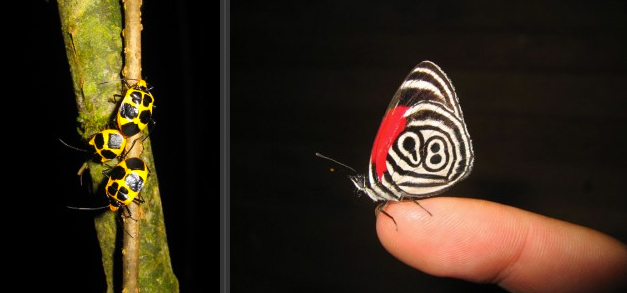
As much as 80% of the insect species in Yasuni National Park have not been described by science. (photo: BU Center for Ecology and Conservation Biology)
SWING: Yeah, the, Chevron, well, actually Chevron bought Texaco several years (ago) and the original complaint here in Ecuador was Texaco, but as a parent company Chevron’s involved now. But essentially Texaco was operating here from the 1970s up until the early 1990s, and during that time there weren’t nearly as many regulations and controls on operations, and so a lot of oil was spilled, you know, slopped around across the landscape. But, yeah, there’s lots of historical oil impacts left over here, and many people have lived through that with direct experiences, and consequently they’re quite hesitant to say, “Well, just let ’em go ahead and extract oil in another pristine area.”
BASCOMB: So, Kelly Swing, what happens next? Is drilling for oil in the I-T-T Block of the Yasuni National Park a done deal, or is there any recourse for the public that’s opposed to it?
SWING: Well, according to the Ecuadorian Constitution, this can be brought to a national vote. The way this works is that there has to be a petition for the government to actually call this to a vote, and the petition has to gather 600,000 signatures. At that point, you know, if it comes to a vote, we don’t know which way it would go. I have a feeling that the government will do some pretty serious campaigning, and Ecuador’s government is excellent at very polished propaganda. I have a feeling, at present, that we are going to see oil extraction in the I-T-T Block in the relatively near future.
BASCOMB: Mmm-hmm. And another part of the Constitution of Ecuador says that nature actually has rights, you know, something akin to human rights. How does this decision, then, to drill for oil in the park, in this portion of the park, square with the Constitution?
SWING: That’s a very good point. The rights of nature, as defined in the Constitution, are basically very similar to the rights of any person. You have the right to exist and to propagate and to reproduce and all these things, and those things are applied to nature here. Despite the fact that this language is available in the Constitution, it hasn’t been tested very well. But I would tend to think that, you know, from the perspective of environmentalists that this may be the time to just absolutely flood the courts with law suits.
BASCOMB: Kelly Swing is Director of Tiputini Biodiversity Station in Yasuni National Park, Ecuador. Thanks for taking the time to talk with me.
SWING: Thanks for giving me the opportunity to spread the word.
CURWOOD: Kelly Swing, director of the Tiputini Biodiversity Station in Yasuni National Park, speaking with LOE's Bobby Bascomb.
Related links:
- Tiputini Biodiversity Station
- National Geographic on Yasuni National Park
[MUSIC: David Barrett “Hummingbird” from Music For Acoustic Guitar (David Barrett Music 2006)]
CURWOOD: Next week on Living on Earth: when the town of West, Texas, blew up, it unveiled a lack of information about chemical accidents
Lathrop: The things that are not being collected as data are frequently horrifying accidents that kill people, but no one in Washington wants to talk about how to keep track of it.
CURWOOD: What's going on - and how to fix it, next time on Living on Earth.
[Daybreak At Iguacu recorded by Dan Grossman & Steve Curwood on location at Iguacu Falls]
SFX RAINFOREST DAWN SOUNDS
CURWOOD: We leave you this week deep in the rain-forest.
CURWOOD: A chorus of brilliant-colored birds greets the dawn near Iguaçu Falls close to the border of Brazil and Argentina.
SFX RAINFOREST SOUNDS
CURWOOD: There are over a hundred bird species in the area -- including toucans, motmots, woodpeckers, flycatchers, antbirds, and manakins. Dan Grossman and I recorded this dawn chorus when we visited the falls a few years ago.
[MUSIC: Anthony Olinger “Moth” from Dance Of The Insects (Anthony Olinger Music 2012)]
CURWOOD: Living on Earth is produced by the World Media Foundation. Naomi Arenberg, Bobby Bascomb, Emmett Fitzgerald, Helen Palmer, Poncie Rutsch, Erin Weeks, Adelaide Chen, James Curwood, Jennifer Marquis and Gabriela Romanow all help to make our show. Jeff Turton is our technical director. Alison Lirish Dean composed our themes. You can find us anytime at LOE.org, and like us on our Facebook page, it’s PRI’s Living on Earth. And we tweet from @LivingOnEarth. I'm Steve Curwood. Thanks for listening.
ANNOUNCER 1: Funding for Living on Earth comes from the Grantham Foundation for the protection of the environment. Supporting strategic communications and collaboration in solving the world’s most pressing environmental problems. The Kendeda Fund, furthering the values that contribute to a healthy planet, and Gilman Ordway for coverage of conservation and environmental change. Living on Earth is also supported by a friend of Red Tomato, supplier of righteous fruits and vegetables from northeast family farms, www.redtomato.org. This is PRI, Public Radio International.
ANNOUNCER 2: PRI, Public Radio International.
Living on Earth wants to hear from you!
Living on Earth
62 Calef Highway, Suite 212
Lee, NH 03861
Telephone: 617-287-4121
E-mail: comments@loe.org
Newsletter [Click here]
Donate to Living on Earth!
Living on Earth is an independent media program and relies entirely on contributions from listeners and institutions supporting public service. Please donate now to preserve an independent environmental voice.
NewsletterLiving on Earth offers a weekly delivery of the show's rundown to your mailbox. Sign up for our newsletter today!
 Sailors For The Sea: Be the change you want to sea.
Sailors For The Sea: Be the change you want to sea.
 The Grantham Foundation for the Protection of the Environment: Committed to protecting and improving the health of the global environment.
The Grantham Foundation for the Protection of the Environment: Committed to protecting and improving the health of the global environment.
 Contribute to Living on Earth and receive, as our gift to you, an archival print of one of Mark Seth Lender's extraordinary wildlife photographs. Follow the link to see Mark's current collection of photographs.
Contribute to Living on Earth and receive, as our gift to you, an archival print of one of Mark Seth Lender's extraordinary wildlife photographs. Follow the link to see Mark's current collection of photographs.
 Buy a signed copy of Mark Seth Lender's book Smeagull the Seagull & support Living on Earth
Buy a signed copy of Mark Seth Lender's book Smeagull the Seagull & support Living on Earth

